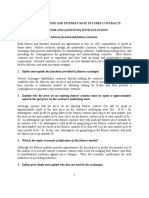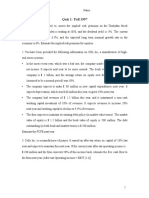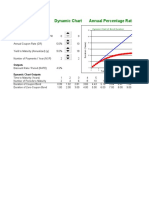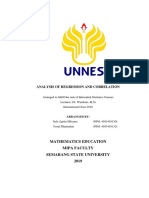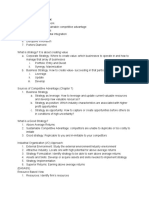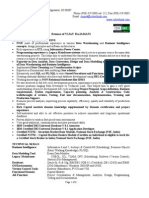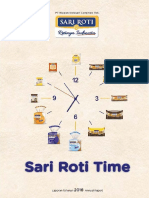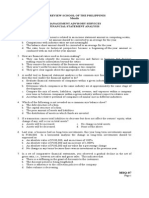0 ratings0% found this document useful (0 votes)
1K viewsBKM CH 03 Answers W CFA
BKM CH 03 Answers W CFA
Uploaded by
Pookguy1. OTC stocks are traded in dealer markets, where dealers set the bid and ask prices. Dealers make a profit from the bid-ask spread. Active stocks will have smaller spreads as more dealers compete to attract business. Inactive stocks will have larger spreads.
2. When short selling a stock, the maximum possible loss is unlimited as the price can rise infinitely. Placing a stop-buy order sets a maximum loss per share equal to the difference between the current price and the stop price.
3. A market order has price uncertainty but not execution uncertainty, as it executes immediately at the best available market price without knowing the exact price in advance.
Copyright:
© All Rights Reserved
Available Formats
Download as DOCX, PDF, TXT or read online from Scribd
BKM CH 03 Answers W CFA
BKM CH 03 Answers W CFA
Uploaded by
Pookguy0 ratings0% found this document useful (0 votes)
1K views10 pages1. OTC stocks are traded in dealer markets, where dealers set the bid and ask prices. Dealers make a profit from the bid-ask spread. Active stocks will have smaller spreads as more dealers compete to attract business. Inactive stocks will have larger spreads.
2. When short selling a stock, the maximum possible loss is unlimited as the price can rise infinitely. Placing a stop-buy order sets a maximum loss per share equal to the difference between the current price and the stop price.
3. A market order has price uncertainty but not execution uncertainty, as it executes immediately at the best available market price without knowing the exact price in advance.
Original Description:
bkm
Original Title
BKM Ch 03 Answers w CFA
Copyright
© © All Rights Reserved
Available Formats
DOCX, PDF, TXT or read online from Scribd
Share this document
Did you find this document useful?
Is this content inappropriate?
1. OTC stocks are traded in dealer markets, where dealers set the bid and ask prices. Dealers make a profit from the bid-ask spread. Active stocks will have smaller spreads as more dealers compete to attract business. Inactive stocks will have larger spreads.
2. When short selling a stock, the maximum possible loss is unlimited as the price can rise infinitely. Placing a stop-buy order sets a maximum loss per share equal to the difference between the current price and the stop price.
3. A market order has price uncertainty but not execution uncertainty, as it executes immediately at the best available market price without knowing the exact price in advance.
Copyright:
© All Rights Reserved
Available Formats
Download as DOCX, PDF, TXT or read online from Scribd
Download as docx, pdf, or txt
0 ratings0% found this document useful (0 votes)
1K views10 pagesBKM CH 03 Answers W CFA
BKM CH 03 Answers W CFA
Uploaded by
Pookguy1. OTC stocks are traded in dealer markets, where dealers set the bid and ask prices. Dealers make a profit from the bid-ask spread. Active stocks will have smaller spreads as more dealers compete to attract business. Inactive stocks will have larger spreads.
2. When short selling a stock, the maximum possible loss is unlimited as the price can rise infinitely. Placing a stop-buy order sets a maximum loss per share equal to the difference between the current price and the stop price.
3. A market order has price uncertainty but not execution uncertainty, as it executes immediately at the best available market price without knowing the exact price in advance.
Copyright:
© All Rights Reserved
Available Formats
Download as DOCX, PDF, TXT or read online from Scribd
Download as docx, pdf, or txt
You are on page 1of 10
1
CHAPTER 3: HOW SECURITIES ARE TRADED
2. Who sets the bid and asked price for a stock traded over the counter (OTC)? Would you expect the
spread to be higher on actively or inactively traded stocks?
OTC stock markets are dealer markets (as opposed to exchange markets like the NYSE). In dealer markets,
the dealer buys the asset from the seller and then holds the assets until he or she is able find a buyer. The
dealers profit comes from buying at the bid and selling at the ask. The difference between the bid and ask is
called the spread. Since all transactions are between sellers and dealers or buyers and dealers, the prices are set
by the dealers.
Active stocks will have more dealers. To compete for business, dealers will decrease the profit margin and
therefore quote smaller (tighter) spreads. Spreads will be larger for inactively traded stocks and smaller on
actively traded stocks.
3. Suppose you short sell 100 shares of IBM, now selling at $120 per share.
(a) What is your maximum possible loss?
Potential losses from a short position are unbounded, since the price can go infinitely high.
(b) What happens to the maximum loss if you simultaneously place a stop-buy order at $128?
The stop-buy order (also known as a stop-loss buy order to go flat) becomes a market buy order if the
stock trades at or above $128. If the order is filled at $128, the maximum loss per share is $8. If the price
of IBM shares goes above $128 before it is filled, the loss would be greater.
4. A market order has:
The answer is (a) Price uncertainty but not execution uncertainty.
A market order is an order to execute the trade immediately at the best possible or current market price. An
advantage is immediate execution. The disadvantage is that the price at which it will be executed at is not
known ahead of time (price uncertainty).
5. Where would an illiquid security in a developing country most likely trade?
Given these three choices, the answer is broker market. Brokers would mitigate search costs in illiquid markets
by finding a counter party for the security. In the US, many illiquid bonds trade through broker markets. A
portfolio manager will contact their representative at a bank with the desire to sell an issue. The broker will
contact other clients to try to place the bond. The broker will either earn a commission or a spread or both. The
broker can also mitigate information asymmetry in illiquid markets by only dealing in reputable securities.
It might be the case that the bank representative acts a dealer and buys the security from the portfolio manager.
Here the dealer is providing liquidity. The dealer is compensated by paying a lower price for the bond with the
expectation of selling it later for a higher price (earning a large spread). The spread compensates the dealer for
risk incurred while holding the bond and for the commitment of capital having the money available to buy the
bond and hold it in inventory. Dealers can also mitigate information asymmetry by only dealing in reputable
securities.
Electronic Limit-Order Markets (ELOM), such as the market for most stocks in the US, are markets which
collect and sort by price and time priority limit orders placed by market participants. ELOM are useful in more
liquid markets where many buyers and sellers are present and information costs are lower (buyers and sellers
are informed about the securities). Continuous auctions with many market participants placing buy and sell
limit orders creates tighter spreads than those typically found on broker or dealer markets. The ELOM charges a
fee to transact on the market instead of earning the spread.
The text uses the term Electronic Crossing Networks but the more common names are Electronic
Communications Network (ECN) and Crossing Network. Both are more useful in liquid markets.
2
Electronic Communications Network (ECN) is a broad term encompassing pretty much any market system that
does not require placing an order with a person. So an ELOM is an ECN but some ECNs are not ELOM.
For example, some ECNs (called dark pools) allow market participants to anonymously place an order for a
stock. The order will be executed with a counter party on the ECN at a price equal to the average price traded
for the stock on all the other markets over a five minute period. This can be useful because the market
participant can execute large a order without affecting the public quote. For example, if a mutual fund wants to
sell a large stock position and places a limit sell order on an ELOM book, the presence of that order might cause
buyers to reconsider and lower the price at which the shares can be sold. The terms Alternative Trading System
(ATS) is often used to describe ECNs that are not ELOMs.
True broker markets still exist for small stocks in the US which do not meet NASDAQ or NYSE listing
requirements. These stocks are traded on the OTCBB or Pink Sheet markets. They are illiquid and have high
information asymmetry.
6. De Trader opens a brokerage account and purchases 300 shares of Internet Dreams at $40 per share.
She borrows $4,000 from her broker to help pay for the purchase. The interest rate on the loan is 8%
(a) What is the margin in De's account when she first purchases the stock
The stock is purchased for 300 $40 = $12,000
The amount borrowed is $4,000.
Therefore, the investor put up equity $8,000
The margin rate is 8,000/12,000 = 66.67%
(b) If the share price falls to $30 per share by the end of the year, what is the remaining margin in her
account? If the maintenance margin requirement is 30%, will she receive a margin call?
If the share price falls to $30, then the value of the stock falls to $9,000.
By the end of the year, the amount of the loan owed to the broker grows to:
$4,000 1.08 = $4,320
Therefore, the remaining margin in the investors account is: $9,000 $4,320 = $4,680
The percentage margin is now: $4,680/$9,000 = 0.52 = 52%
Therefore, the investor will not receive a margin call.
(c) What is the rate of return on her investment?
The rate of return on the investment over the year is:
(Ending equity in the account Initial equity)/Initial equity
= ($4,680 $8,000)/$8,000 = 0.415 = 41.5%
7. Old Economy Traders opened an account to short sell 1,000 shares of Internet Dreams from the previous
problem. The initial margin requirement was 50%. (The margin account pays no interest.) A year later,
the price of Internet Dreams has risen from $40 to $50, and the stock has paid a dividend of $2 per share.
(a) What is the remaining margin in the account?
(See the calculations below)
The trader put up $20,000
The trader lost $10,000 in the share price move ($10 x 1000)
The trader paid $2,000 in dividends ($2 x 1000)
Ending Equity = $20,000 - $10,000 - $2,000 = $8,000
(b) If the maintenance margin requirement is 30%, will Old Economy receive a margin call?
Margin Rate = Equity / Liability is: $8,000/$50,000 = 0.16 = 16%
So there will be a margin call.
(c) What is the rate of return on her investment?
The equity in the account decreased from $20,000 to $8,000 in one year.
3
Return = -$12,000/$20,000 = -0.60 = -60%
Calculations:
Beginning of the Year:
Assets
Liabilities & Equity
Cash from Stock Sale = $40 x 1000 = $40,000
Value of Stocks Owed = 1000 x $40 = $40,000
Margin Cash = $20,000
Equity = $60,000 - $40,000 = $20,000
Total Assets = $60,000
Margin Rate = Equity/Value of Stocks Owed = Equity/(Shares x P)
Margin Rate = $20,000/(1000 x $40) = 0.50
End of the Year:
Price = $50
Dividend Payable = 1000 x $2 = $2,000
Assets
Liabilities & Equity
Cash from Stock Sale = $40 x 1000 = $40,000
Value of Stocks Owed = 1000 x $50 = $50,000
Margin Cash = $20,000
Div Payable = $2,000
Total Assets = $60,000
Equity = $60,000 - $50,000 - $2,000 = $8,000
Once the Dividend is Paid:
Assets
Liabilities & Equity
Cash from Stock Sale = $40 x 1000 = $40,000
Value of Stocks Owed = 1000 x $50 = $50,000
Margin Cash = $20,000 - $2,000 = $18,000
Equity = $58,000 - $50,000 = $8,000
Total Assets = $58,000
Margin Rate = Equity/Value of Stocks Owed = Equity/(Shares x P)
Margin Rate = $8,000/(1000 x $50) = 0.16
8. Consider the following limit-order book of a specialist. The last trade in the stock occurred at a price of
$50.
Limit Buy Orders
Limit Sell Orders
Price Shares Price Shares
$49.75 500
$50.25 100
$49.50 800
$51.50 100
$49.25 500
$54.75 300
$49.00 200
$58.25 100
$48.50 600
(a) If a market buy order for 100 shares comes in, at what price will it be filled?
At the best (lowest) limit-sell order price: $50.25
(b) At what price would the next market buy order (after the 100 shares in part (a)) be filled?
At the next-best limit-sell order price: $51.50
(c) If you were the specialist, would you want to increase or decrease your inventory of this stock?
You would want to increase your inventory. There is considerable buying demand at prices just below $50,
indicating that downside risk is limited. In contrast, limit sell orders are sparse. If the assumption is that
there is equal probability that the next order will be either a buy or sell, then the price is more likely to rise
a lot since a moderate size buy order (501 shares) would result in a price increase to $58.25 while a
moderate size sell order (501 shares) would cause the price to drop to $49.50.
So the point of the question is to recognize that the sell-side of the limit-order book is very thin and the
buy-side is deep. HOWEVER, how can the market maker increase his or her position in the stock without
affecting the limit order book? That is not easily answered.
4
9. You are bullish on Telecom stock. The current market price is $50 per share, and you have $5,000 of your
own to invest. You borrow an additional $5,000 from your broker at an interest rate of 8% per year and
invest $10,000 in the stock.
(a) What will be your rate of return if the price of Telecom stock goes up by 10% during the next year?
The stock currently pays no dividends.
Increase in share value = 10% x $10,000 = $1,000
Interest Expense = 8% $5,000 = $400
Return = ($1,000 - $400)/$5,000 = 0.12 = 12.00%
(b) How far does the price of Telecom stock have to fall for you to get a margin call if the maintenance
margin is 30%? Assume the price fall happens immediately.
The value of the Assets is the value of the 200 shares (200P).
Liabilities = Loan amount = $5,000
Margin Rate = Equity/Assets = (Assets Liabilities)/Assets = (200P $5,000)/200P
You will receive a margin call if Margin Rate < 0.30
Margin Call if (200P $5,000)/200P < 0.30
Solve for P:
Margin call if P < $35.71
10. You are bearish on Telecom and decide to sell short 100 shares at the current market price of $50 per
share.
(a) How much in cash or securities must you put into your brokerage account if the broker's initial
margin requirement is 50% of the value of the short position?
Initial Margin = 50% x 100 x $50 = $2,500.
(b) How high can the price of the stock go before you get a margin call if the maintenance margin is 30%
of the value of the short position?
Total assets are $7,500 ($5,000 from the sale of the stock and $2,500 put up for margin).
Liabilities are 100P.
Equity is ($7,500 100P).
A margin call if ($7,500 100P)/200P < 0.30
P > $57.69
11. Suppose that Intel currently is selling at $40 per share. You buy 500 shares using $15,000 of your own
money, borrowing the remainder of the purchase price from your broker. The rate on the margin loan is
8%.
(a) What is the percentage increase in the net worth of your brokerage account if the price of Intel
immediately changes to: (i) $44; (ii) $40; (iii) $36? What is the relationship between your percentage
return and the percentage change in the price of Intel?
Assets = $40 500 = $20,000
Liability = $5,000
Equity = $15,000.
(i) Price to $44
Equity = Assets Liabilities = ($44 500) $5,000 = $17,000
Return = $17,000/$15,000 1 = 0.1333 = 13.33%
(ii) Price at $40
Equity = Assets Liabilities = ($40 500) $5,000 = $15,000
Return = $15,000/$15,000 1 = 0%
(iii) Price at $36
Equity = Assets Liabilities = ($36 500) $5,000 = $13,000
Return = $13,000/$15,000 1 = -0.1333 = -13.33%
5
The relationship between the Margin Return and the Stock Return is given by:
Margin Return = Stock Return Assets/Equity
Assets/Equity is a leverage measure so the stocks return (the assets return) is increased by the leverage
ratio.
For example, when the stock price rises from $40 to $44, the stock return is 10%
The Equity Return = 10% ($20,000/$15,000) = 10% 1.333 = 13.33%
1.333 is the leverage measure.
(b) If the maintenance margin is 25%, how low can Intel's price fall before you get a margin call?
The value of the Assets is the value of the 500 shares (500P).
Liabilities = Loan amount = $5,000
Margin Rate = Equity/Assets = (Assets Liabilities)/Assets = (500P $5,000)/500P
You will receive a margin call if Margin Rate < 0.25
Margin Call if (500P $5,000)/500P < 0.25
Solve for P: Margin call if P < $13.33
(c) How would your answer to (b) change if you had financed the initial purchase with only $10,000 of
your own money?
The value of the Assets is the value of the 500 shares (500P).
Liabilities = Loan amount = $10,000
Margin Rate = Equity/Assets = (Assets Liabilities)/Assets = (500P $10,000)/500P
Margin Call if (500P $10,000)/500P < 0.25
Margin call if P < $26.67
With less equity, more levered, more vulnerable to a margin call.
(d) What is the rate of return on your margined position (assuming again that you invest $15,000 of your
own money) if Intel is selling after 1 year at: (i) $44; (ii) $40; (iii) $36? What is the relationship
between your percentage return and the percentage change in the price of Intel? Assume that Intel
pays no dividends.
At the end of 1 year, the loan amount (liability) = $5,000(1 + 0.08) = $5,400
(i) Price to $44
Equity = Assets Liabilities = ($44 500) $5,400 = $16,600
Return = $16,600/$15,000 1 = 0.1067 = 10.67%
(ii) Price at $40
Equity = Assets Liabilities = ($40 500) $5,400 = $14,600
Return = $14,600/$15,000 1 = -0.0267 = -2.67%%
(iii) Price at $36
Equity = Assets Liabilities = ($36 500) $5,400 = $12,600
Return = $12,600/$15,000 1 = -0.1600 = -16.00%
The relationship between the Margin Return and the Stock Return is given by:
Margin Return = (Stock Return Assets/Equity) (Loan Rate x Liabilities/Equity)
For example, when the stock price rises from $40 to $44, the stock return is 10%
Equity Return = (10% ($20,000/$15,000)) (8% ($5,000/$15,000))
= (10% 1.333) (8% 0.333) = 13.33% 2.67% = 10.67%
(e) Continue to assume that a year has passed. How low can Intel's price fall before you get a margin
call?
The value of the Assets is the value of the 500 shares (500P).
Liabilities = Loan amount x 1.08 = $5,400
Margin Rate = Equity/Assets = (Assets Liabilities)/Assets = (500P $5,400)/500P
6
You will receive a margin call if Margin Rate < 0.25
Margin Call if (500P $5,400)/500P < 0.25
Solve for P:
Margin call if P < $14.40
12. Suppose that you sell short 500 shares of Intel, currently selling for $40 per share, and give your broker
$15,000 to establish your margin account.
(a) If you earn no interest on the funds in your margin account, what will be your rate of return after 1
year if Intel stock is selling at: (i) $44; (ii) $40; (iii) $36? Assume that Intel pays no dividends.
Assets = Invested Cash + Proceeds from Short Sale = $15,000 + ($40 500) = $35,000
Liability = Value of 500 Shares Owed = 500P
Equity = Assets Liabilities = $35,000 500P
(i) Price to $44
Equity = Assets Liabilities = $35,000 ($44 500) = $35,000 $22,000 = $13,000
Return = $13,000/$15,000 1 = -0.1333 = -13.33%
(ii) Price at $40
Equity = Assets Liabilities = $35,000 ($40 500) = $35,000 $20,000 = $15,000
Return = $15,000/$15,000 1 = 0%
(iii) Price at $36
Equity = Assets Liabilities = $35,000 ($36 500) = $35,000 $18,000 = $17,000
Return = $17,000/$15,000 1 = 0.1333 = 13.33%
(b) If the maintenance margin is 25%, how high can Intel's price rise before you get a margin call?
Assets = Invested Cash + Proceeds from Short Sale = $15,000 + ($40 500) = $35,000
Liability = Value of 500 Shares Owed = 500P
Equity = Assets Liabilities = $35,000 500P
Margin Rate = Equity/Liabilities = ($35,000 500P)/500P
You will receive a margin call if Margin Rate < 0.25
Margin Call if ($35,000 500P)/500P < 0.25
Margin call if P > $56.00
(c) Redo parts (a) and (b), but now assume that Intel also has paid a year-end dividend of $1 per share.
The prices in part (a) should be interpreted as ex-dividend, that is, prices after the dividend has been
paid.
The dividend is either payable to the entity from which the short borrowed the shares in which case the
liability is greater by the dividend amount or the dividend has been paid to the entity from which the short
borrowed the shares in which case the assets (cash) is lower.
Assets = Invested Cash + Proceeds from Short Sale Dividend
= $15,000 + ($40 500) ($1 $500) = $34,500
Liability = Value of 500 Shares Owed = 500P
Equity = Assets Liabilities = $34,500 500P
(i) Price to $44
Equity = Assets Liabilities = $34,500 ($44 500) = $34,500 $22,000 = $12,500
Return = $12,500/$15,000 1 = -0.1333 = -13.33%
(ii) Price at $40
Equity = Assets Liabilities = $34,500 ($40 500) = $34,500 $20,000 = $14,500
Return = $14,500/$15,000 1 = -3.33%
(iii) Price at $36
Equity = Assets Liabilities = $34,500 ($36 500) = $34,500 $18,000 = $16,500
Return = $16,500/$15,000 1 = 15%
7
Note that if we assume the dividend is still payable to the entity from which the short borrowed the shares,
then assets and liabilities each increase by $500 so equity is unchanged.
Assets = Invested Cash + Proceeds from Short Sale Dividend
= $15,000 + ($40 500) ($1 $500) = $34,500
Liability = Value of 500 Shares Owed = 500P
Equity = Assets Liabilities = $34,500 500P
Margin Rate = Equity/Liabilities = ($34,500 500P)/500P
You will receive a margin call if Margin Rate < 0.25
Margin Call if ($34,500 500P)/500P < 0.25
Margin call if P > $55.20
14. The bid on Fincorp is $55.25 and the ask is $55.50.
(a) Suppose you have submitted an order to your broker to buy at market. At what price will your trade
be executed?
$55.50 (the best ask)
(b) Suppose you have submitted an order to your broker to sell at market. At what price will your trade
be executed?
$55.25 (the best bid)
(c) Suppose you have submitted a limit order to sell at $55.62. What will happen?
Your order will not be executed immediately. It will be placed in the limit order book behind the best ask of
$55.50.
(d) Suppose you have submitted a limit order to buy at $55.37. What will happen?
Your order will not be executed immediately. It will be placed in the limit order book ahead of the $55.25
and become the best bid.
16. You've borrowed $20,000 on margin to buy shares in Disney, which is now selling at $40 per share. Your
account starts at the initial margin requirement of 50%. The maintenance margin is 35%. Two days
later, the stock price falls to $35 per share.
(a) Will you receive a margin call?
Initial Margin = Equity/Assets = 50%
The means you put up the same amount that you borrowed so
Equity = $20,000
Liabilities = $20,000
Assets = $40,000 = 1,000 shares x $40
Margin Rate = Equity/Assets = (Assets Liabilities)/Assets = (1,000P $20,000)/1,000P
= [(1,000 x $35) - $20,000]/(1,000 x $35) = 0.4286 = 42.86% > 35%
So no margin call
(b) How low can the price of Disney shares fall before you receive a margin call?
Margin Call if (1,000P $20,000)/1,000P < 0.35
Solve for P:
Margin call if P < $30.77
8
Extra Margin and Short Position Questions
1. An investor puts up $20,000 to take a long position in a stock with a price of $50.
(a) If the initial margin rate on the position is 80%, how many shares can the investor purchase? What
dollar amount the investor is borrowing from the brokerage firm?
Number of Shares = (Dollars invested/Margin Rate)/P
0
= ($20,000/0.80)/$50 = 500 shares
Loan Amount = $20,000/0.80 $20,000 = $5,000
Assets
Liabilities & Equity
Stock = $50 x 500 = $25,000
Loan = $5,000
Equity = $25,000 - $5,000 = $20,000
(b) Assume the investor will receive a margin call if the margin rate drops below 30%. Below what price will
the investor receive a margin call? (Assume the price change is immediate so you can ignore the dividend
yield and interest on the loan.)
Margin Rate = Equity/Stock Value = (Stock Value Loan)/Stock Value = (Shares x P Loan)/(Shares x P)
Solve for P and plug in values:
P = Loan/[Shares x (1 Margin Rate)] = $5,000/[500 x (1 0.30)] = $14.29
Check Margin rate at P = 14.29:
Margin Rate = (Shares x P Loan)/(Shares x P) = (500 x $14.29 - $5,000)/(500 x $14.29) = $2,145/$7,145 = 30%
(c) Calculate the return on the stock at the margin call price. Calculate the return on the investors equity at
the margin call price. Calculate the ratio of the return on the stock to the return on the investors equity.
How does this ratio compare to the initial margin rate?
Stock Return = $14.29/$50 1 = -71.42%
Investors Equity Return = $2,145/$20,000 1 = -89.28%
Stock Return/Equity Return = -71.42%/-89.28% = 80%
The ratio equals the initial margin rate.
(d) Assume the stock pays a single annual dividend of $1.50 one year from today. If, at the end of the year,
the stocks price is $45, calculate the total return on the stock over the year.
Stock Return = (P
1
+ Div)/P
0
1 = ($45 + 1.50)/$50 1 = $46.50/$50 1 = -7.00%
Note that this is equal to the capital gain return plus the dividend yield:
Cap Gain Return = 45/50 1 = -10% and Dividend Yield = $1.50/$50 = 3%
Stock Return = -10% + 3% = 7%
(e) If the investors broker charges 8% on margin loans, calculate the return on the investors equity over
the year.
First calculate the new Equity:
Assets
Liabilities & Equity
Stock = $45 x 500 = $22,500
Loan = $5,000(1.08) = $5,400
Div Cash = $1.50 x 500 = $750
Equity = $23,250 - $5,400 = $17,850
Total Assets = $23,250
Investors Equity Return = $17,850/$20,000 1 = -10.75%
9
2. An investor puts up $30,000 and takes a SHORT position in a stock with a price of $100.
(a) If the initial margin rate is 50%, how many shares can the investor short?
Number of Shares = (Dollars invested/Margin Rate)/P
0
= ($30,000/0.50)/$100 = 600 shares
Assets
Liabilities & Equity
Cash from Stock Sale = $100 x 600 = $60,000
Value of Stocks Owed = 600 x $100 = $60,000
Margin Cash = $30,000
Equity = $90,000 - $60,000 = $30,000
Total Assets = $90,000
Margin Rate = Equity/Value of Stocks Owed = Equity/(Shares x P)
Margin Rate = $30,000/(600 x $100) = 0.50
(b) Assume the investor will receive a margin call if the margin rate drops below 30%. ABOVE what price
will the investor receive a margin call? (Assume the price change is immediate so you can ignore the
dividend yield and interest expense.)
Margin Rate = Equity/Value of Stocks Owed = (Total Assets Shares x P)/(Shares x P)
Solve for P and plug in values:
P = Total Assets/[Shares x (1 + MR)] = 90,000/[600(1 + 0.30)] = $115.38
Check Margin rate at P = $115.38:
Margin Rate = Equity/Value of Stocks Owed = (Total Assets Shares x P)/(Shares x P)
Margin Rate = ($90,000 600 x $115.38)/(600 x $115.38) = ($90,000 $69,228)/$69,228
Margin Rate = $20,772/$69,228 = 30%
(c) Calculate the return on the stock at the margin call price. Calculate the return on the investors equity at
the margin call price. Calculate the ratio on the return on the stock to the return on the investors equity.
How does this ratio compare to the margin rate?
Stock Return = $115.38/$100 1 = 15.38%
Investors Equity Return = $20,772/$30,000 1 = -30.76%
Stock Return/Equity Return = 15.38%/-30.76% = -50%
The ratio equals the negative of the margin rate.
(d) Assume the stock pays a single annual dividend of $4.00 one year from today. If, at the end of the year,
the stocks price is $90, calculate the total return on the stock over the year.
Stock Return = (P
1
+ Div)/P
0
1 = ($90 + $4)/$100 1 = $94/$100 1 = -6.00%
(e) Assume the broker charges 5% on borrowed shares (calculated on the initial value of the position) and
you earn 2% on the margin cash in the account. Calculate the return on the investors equity over the
year.
First calculate the new equity:
Assets
Liabilities & Equity
Cash from Stock Sale = $60,000
Current Value of Stocks Owed = 600 x $90 = $54,000
Margin Cash = $30,000(1.02) = $30,600
Interest Payable on Borrowed Stocks = $60,000(0.05) = $3,000
Total Assets = $90,600
Dividend Payable = 600 x $4 = $2,400
Equity = $90,600 - $54,000 - $3,000 - $2,400 = $31,200
Note that I have listed the Interest and Dividends as payable liabilities.
Once paid, the amount of cash decreases so Equity does not change.
Investors Equity Return = $31,200/$30,000 1 = 4.00%
The price dropped 10% and the investor was levered 2 to 1, but the cost of the short decreased the profit to 4.00%.
10
CFA PROBLEMS
1. a. In addition to the explicit fees of $70,000, FBN appears to have paid an implicit price in underpricing
of the IPO. The underpricing is $3 per share, or a total of $300,000, implying total costs of $370,000.
b. No. The underwriters do not capture the part of the costs corresponding to the underpricing. The
underpricing may be a rational marketing strategy. Without it, the underwriters would need to spend
more resources in order to place the issue with the public. The underwriters would then need to charge
higher explicit fees to the issuing firm. The issuing firm may be just as well off paying the implicit
issuance cost represented by the underpricing.
2. (d) The broker will sell, at current market price, after the first transaction at $55 or less.
3. (d)
You might also like
- Chapter 11 SolutionsDocument14 pagesChapter 11 SolutionsEdmond ZNo ratings yet
- SolutionsDocument6 pagesSolutionsElenaNo ratings yet
- Quantitative Equity Portfolio Management: An Active Approach to Portfolio Construction and ManagementFrom EverandQuantitative Equity Portfolio Management: An Active Approach to Portfolio Construction and ManagementRating: 4.5 out of 5 stars4.5/5 (2)
- Corporate Finance ExamDocument26 pagesCorporate Finance ExamRaman SrinivasanNo ratings yet
- BUSI 353 S18 Assignment 3 All RevenueDocument5 pagesBUSI 353 S18 Assignment 3 All RevenueTanNo ratings yet
- Tutorial 6 AnswersDocument5 pagesTutorial 6 AnswersMaria MazurinaNo ratings yet
- Practice Midterm SolutionsDocument18 pagesPractice Midterm SolutionsGNo ratings yet
- Circuit City Accounting CaseDocument4 pagesCircuit City Accounting CasePookguyNo ratings yet
- INA W5Formative TSDocument5 pagesINA W5Formative TSNayden GeorgievNo ratings yet
- BKM CH 03 Answers W CFADocument8 pagesBKM CH 03 Answers W CFAAmyra KamisNo ratings yet
- FM 2012 WorksheetDocument9 pagesFM 2012 WorksheetBeing ShonuNo ratings yet
- Assignment 3 SolutionsDocument5 pagesAssignment 3 SolutionsFaas1337No ratings yet
- Description of Knoll:: Knoll Furniture: Going PublicDocument3 pagesDescription of Knoll:: Knoll Furniture: Going PublicIni EjideleNo ratings yet
- Quiz1 PDFDocument45 pagesQuiz1 PDFShami Khan Shami KhanNo ratings yet
- Bond Duration - Dynamic ChartDocument3 pagesBond Duration - Dynamic Chartapi-3763138No ratings yet
- Lesson Five HomeworkDocument3 pagesLesson Five HomeworkLiam100% (1)
- Stock-Trak Project Final Preparation GuidlinesDocument1 pageStock-Trak Project Final Preparation GuidlinesKim Yoo SukNo ratings yet
- Corporate Finance ExercisesDocument14 pagesCorporate Finance ExercisesMatteoNebiolo100% (2)
- Macsg11: Money Demand and Equilibrium Interest RateDocument23 pagesMacsg11: Money Demand and Equilibrium Interest RateJudithNo ratings yet
- JC Penney Group Project 042513 V 2Document35 pagesJC Penney Group Project 042513 V 2Pookguy100% (2)
- Financial Risk Management ExercisesDocument20 pagesFinancial Risk Management ExercisesChau NguyenNo ratings yet
- Assignment1 - Group 8Document8 pagesAssignment1 - Group 8digamber patilNo ratings yet
- BKM CH 04 AnswersDocument9 pagesBKM CH 04 Answerseric3765No ratings yet
- Business Economics ICFAIDocument20 pagesBusiness Economics ICFAIDaniel VincentNo ratings yet
- CoorsDocument2 pagesCoorsdizenz07No ratings yet
- BKM CH 06 Answers W CFADocument11 pagesBKM CH 06 Answers W CFAAhmed Bashir100% (19)
- BUSI 353 S18 Assignment 4 SOLUTIONDocument2 pagesBUSI 353 S18 Assignment 4 SOLUTIONTanNo ratings yet
- Ch. 3,4,5,6 - Study PlanDocument185 pagesCh. 3,4,5,6 - Study PlanIslamNo ratings yet
- CH 06Document73 pagesCH 06Sarang AdgokarNo ratings yet
- BUSI 353 S18 Assignment 6 SOLUTIONDocument4 pagesBUSI 353 S18 Assignment 6 SOLUTIONTanNo ratings yet
- EXAM 1 IPM Solutions Spring 2012 (B)Document12 pagesEXAM 1 IPM Solutions Spring 2012 (B)kiffeur69100% (6)
- Costco - 5 ForcesDocument2 pagesCostco - 5 ForcesAditya JandialNo ratings yet
- Corporate Finance: Laurence Booth - W. Sean Cleary Chapter 7 - Equity ValuationDocument64 pagesCorporate Finance: Laurence Booth - W. Sean Cleary Chapter 7 - Equity ValuationShailesh RathodNo ratings yet
- Macro QuizDocument10 pagesMacro Quizching lamNo ratings yet
- Topic 3 AnswersDocument8 pagesTopic 3 AnswersStephanieNo ratings yet
- Analysis of Regression and CorrelationDocument56 pagesAnalysis of Regression and CorrelationKIM SPARTANNo ratings yet
- Chapter 17 Solutions BKM Investments 9eDocument11 pagesChapter 17 Solutions BKM Investments 9enpiper29100% (1)
- Forward ExerciseDocument2 pagesForward ExerciseThanh TuyềnNo ratings yet
- Pablo Fernandez WACCDocument8 pagesPablo Fernandez WACCDaniel ŠtekovićNo ratings yet
- Chap 002Document100 pagesChap 002Duy AAnhNo ratings yet
- International Financial Management - Geert Bekaert Robert Hodrick - Chap 02 - SolutionDocument4 pagesInternational Financial Management - Geert Bekaert Robert Hodrick - Chap 02 - SolutionFagbola Oluwatobi OmolajaNo ratings yet
- Exam ReviewerDocument6 pagesExam ReviewerInah RoblesNo ratings yet
- CH 6Document5 pagesCH 6pinoNo ratings yet
- 2.3 Fra and Swap ExercisesDocument5 pages2.3 Fra and Swap ExercisesrandomcuriNo ratings yet
- Macsg12: Aggregate Demand in The Money Goods and Current MarketsDocument30 pagesMacsg12: Aggregate Demand in The Money Goods and Current MarketsJudithNo ratings yet
- Chap 012Document15 pagesChap 012van tinh khuc100% (2)
- Investment BKM 5th EditonDocument21 pagesInvestment BKM 5th EditonKonstantin BezuhanovNo ratings yet
- Macro Chap 11 Exercise Macsg11-Money-Demand-And-Equilibrium-Interest-Rate PDFDocument23 pagesMacro Chap 11 Exercise Macsg11-Money-Demand-And-Equilibrium-Interest-Rate PDFAA BB MM50% (2)
- The Mock Test2923Document15 pagesThe Mock Test2923elongoria278No ratings yet
- MarketshomeworkDocument2 pagesMarketshomeworkMae BawaganNo ratings yet
- Technical Analysis of The Size PremiumDocument4 pagesTechnical Analysis of The Size PremiumRamiro Gamen0% (1)
- Fsav 6e Test Bank Mod15 TF MC 102720Document21 pagesFsav 6e Test Bank Mod15 TF MC 102720pauline leNo ratings yet
- Fae3e SM ch03Document19 pagesFae3e SM ch03JarkeeNo ratings yet
- Chapter 5 6 - Solutions For Recommended End-Of-Chapter ProblemsDocument5 pagesChapter 5 6 - Solutions For Recommended End-Of-Chapter Problemsminh vận đỗNo ratings yet
- BKM CH 11 Answers W CFADocument10 pagesBKM CH 11 Answers W CFAlevajunk80% (5)
- 5021 Solutions 6Document5 pages5021 Solutions 6americus_smile7474100% (2)
- FM11 CH 16 Mini-Case Cap Structure DecDocument11 pagesFM11 CH 16 Mini-Case Cap Structure DecAndreea VladNo ratings yet
- FRT - HM Research-Report V.finalDocument47 pagesFRT - HM Research-Report V.finalANH PHAM QUYNHNo ratings yet
- Finnews Q5Document48 pagesFinnews Q5lifeeeNo ratings yet
- FIN 432 - Investment Analysis and Management Review Notes For Midterm ExamDocument15 pagesFIN 432 - Investment Analysis and Management Review Notes For Midterm ExamPhuc Hong PhamNo ratings yet
- A 109 SMDocument39 pagesA 109 SMRam Krishna KrishNo ratings yet
- Administrative Assistant Hello,: (Your Name)Document1 pageAdministrative Assistant Hello,: (Your Name)PookguyNo ratings yet
- Feedback: Doogar Spring 2014 17 April 2014Document6 pagesFeedback: Doogar Spring 2014 17 April 2014PookguyNo ratings yet
- Team7 340 Team ContractDocument1 pageTeam7 340 Team ContractPookguyNo ratings yet
- Lego StudentDocument7 pagesLego StudentPookguy100% (1)
- SPEP Leadership Desciptions FY15Document3 pagesSPEP Leadership Desciptions FY15PookguyNo ratings yet
- Fin 3013 Chapter 4Document46 pagesFin 3013 Chapter 4PookguyNo ratings yet
- FNHB Annual Report 2020 (Part 1)Document83 pagesFNHB Annual Report 2020 (Part 1)KentwcNo ratings yet
- Tax Alert - 2005 - FebDocument11 pagesTax Alert - 2005 - FebzhanleriNo ratings yet
- CHAPTER NO D Cost of Capital and Portfolio ManagementDocument124 pagesCHAPTER NO D Cost of Capital and Portfolio Managementzaheer shahzadNo ratings yet
- Case Digest of Nielson & Co., Inc. Vs LepantoDocument3 pagesCase Digest of Nielson & Co., Inc. Vs LepantoChester Pryze Ibardolaza Tabuena100% (1)
- Resume of Vijay Rajamani: Amjad PathanDocument6 pagesResume of Vijay Rajamani: Amjad Pathanmanraj123No ratings yet
- Acc 109 p2 Quiz Statement of Comprehensive IncomeDocument11 pagesAcc 109 p2 Quiz Statement of Comprehensive IncomeRonel CastillonNo ratings yet
- Business Communication WorkbookDocument20 pagesBusiness Communication Workbookjatinsingh110205No ratings yet
- Chapter 9 - Operations, Dividends, BVPS, & EPSDocument6 pagesChapter 9 - Operations, Dividends, BVPS, & EPSSarah Nicole S. LagrimasNo ratings yet
- Far CeggDocument17 pagesFar CeggMaurice AgbayaniNo ratings yet
- Annual Report Sari Roti PDFDocument220 pagesAnnual Report Sari Roti PDFAmalia AshariNo ratings yet
- Naeem Ullah: Registration #: 91116Document4 pagesNaeem Ullah: Registration #: 91116Naeem MalikNo ratings yet
- Fast Food Restaurant Business PlanDocument6 pagesFast Food Restaurant Business PlanChris MineNo ratings yet
- Swift Messaging Factsheet Corporateactions56104Document4 pagesSwift Messaging Factsheet Corporateactions56104kartikb60No ratings yet
- Strategic Financial Management-84-97-5Document1 pageStrategic Financial Management-84-97-5joko waluyoNo ratings yet
- GKJ Taxation Final (Sums)Document7 pagesGKJ Taxation Final (Sums)ankandas3498No ratings yet
- Partnership ProblemsDocument46 pagesPartnership ProblemsJames R JunioNo ratings yet
- Project On NJ India Invest PVT LTDDocument68 pagesProject On NJ India Invest PVT LTDbabloo200650% (2)
- NP Ex 4-1Document13 pagesNP Ex 4-1anhnguyen141203No ratings yet
- Chapter 2Document7 pagesChapter 2cerayNo ratings yet
- Eva Eko Hidayati-01Document14 pagesEva Eko Hidayati-01CahMbelingNo ratings yet
- Unit 2Document17 pagesUnit 2Make Me GyaniNo ratings yet
- Module 3 (Debt and Equity Securities)Document7 pagesModule 3 (Debt and Equity Securities)pineda.keesha414No ratings yet
- Ratio Reviewer 2Document15 pagesRatio Reviewer 2Edgar Lay60% (5)
- Update: Intermediate Accounting 15EDocument10 pagesUpdate: Intermediate Accounting 15ENarissa Mae QuijanoNo ratings yet
- Chapter 1 - LiabilitiesDocument8 pagesChapter 1 - LiabilitiesHerrika Red Gullon RoseteNo ratings yet
- CTM India Limited FinancialDocument51 pagesCTM India Limited FinancialIncome with WealthNo ratings yet
- Chapter 9 AIFS Complete Notes With QuestionsDocument71 pagesChapter 9 AIFS Complete Notes With Questionschananakartik1No ratings yet
- As 9 Revenue RecognitionDocument6 pagesAs 9 Revenue Recognitionhealthylifestyle21tipsNo ratings yet
- Accounting Answer KeyDocument52 pagesAccounting Answer Keylisa cogollodoNo ratings yet
